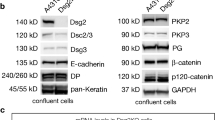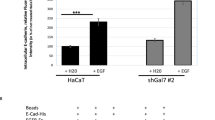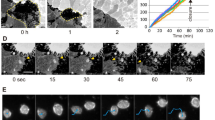Abstract
Desmosomes are intercellular junctions of epithelia and are of widespread importance in the maintenance of tissue architecture. We provide evidence that desmosomal adhesion has a function in epithelial morphogenesis and cell-type-specific positioning. Blocking peptides corresponding to the cell adhesion recognition (CAR) sites of desmosomal cadherins block alveolar morphogenesis by epithelial cells from mammary lumen. Desmosomal CAR-site peptides also disrupt positional sorting of luminal and myoepithelial cells in aggregates formed by the reassociation of isolated cells. We demonstrate that desmosomal cadherins and E-cadherin are comparably involved in epithelial morphoregulation. The results indicate a wider role for desmosomal adhesion in morphogenesis than has previously been considered.
This is a preview of subscription content, access via your institution
Access options
Subscribe to this journal
Receive 12 print issues and online access
We are sorry, but there is no personal subscription option available for your country.
Buy this article
- Purchase on SpringerLink
- Instant access to full article PDF
Prices may be subject to local taxes which are calculated during checkout







Similar content being viewed by others
References
Townes, P. L. & Holtfreter, J. Directed movements and selective adhesion of embryonic amphibian cells. J. Exp. Zool. 128, 53–120 (1955).
Steinberg, M. S. in Cellular Membranes in Development (ed. Locke, M.) 321–366 (Academic, New York, 1964).
Koch, P. J. et al. _targeted disruption of the pemphigus vulgaris antigen (desmoglein 3) gene in mice causes loss of keratinocyte cell adhesion with a phenotype similar to pemphigus vulgaris. J. Cell Biol. 137, 1091–1102 (1997).
McGrath, J. A. et al. Mutations in the plakophilin 1 gene result in ectodermal dysplasia/skin fragility syndrome. Nature Genet. 17, 240–244 (1997).
Bierkamp, C., McLaughlin, K. J., Schwarz, H., Huber, O. & Kemler, R. Embryonic heart and skin defects in mice lacking plakoglobin. Dev. Biol. 180, 780–785 (1996).
Ruiz, P. et al. _targeted mutation of plakoglobin in mice reveals essential functions of desmosomes in the embryonic heart. J. Cell Biol. 135, 215–225 (1996).
Gallicano, G. I. et al. Desmoplakin is required early in development for assembly of desmosomes and cytoskeletal linkage. J. Cell Biol. 143, 2009–2022 (1998).
Amagai, M., Matsuyoshi, Z. H., Andl, C. & Stanley, J. R. Toxin in bullous impetigo and staphylococcal scalded-skin syndrome _targets desmoglein 1. Nature Med. 6, 1275–1277 (2000).
Fleming, T. P., Garrod, D. R. & Elsmore, A. J. Desmosome biogenesis in the mouse preimplantation embryo. Development 112, 527–539 (1991).
Chitaev, N. A. & Troyanovsky, S. M. Direct Ca2+-dependent heterophilic interaction between desmosomal cadherins, desmoglein and desmocollin, contributes to cell–cell adhesion. J. Cell Biol. 138, 193–201 (1997).
Marcozzi, C., Burdett, I. D., Buxton, R. S. & Magee, A. I. Coexpression of both types of desmosomal cadherin and plakoglobin confers strong intercellular adhesion. J. Cell Sci. 111, 495–509 (1998).
Tselepis, C., Chidgey, M., North, A. & Garrod, D. Desmosomal adhesion inhibits invasive behaviour. Proc. Natl Acad. Sci. USA 95, 8064–8069 (1998).
Garrod, D., Chidgey, M. & North, A. Desmosomes: differentiation, development, dynamics and disease. Curr. Opin. Cell Biol. 8, 670–678 (1996).
Arnemann, J., Sullivan, K. H., Magee, A. I., King, I. A. & Buxton, R. S. Stratification-related expression of isoforms of the desmosomal cadherins in human epidermis. J. Cell Sci. 104, 741–750 (1993).
Legan, P. K. et al. The bovine desmocollin family: a new gene and expression patterns reflecting epithelial cell proliferation and differentiation. J. Cell Biol. 126, 507–518 (1994).
Schäfer, S., Koch, P. J. & Franke, W. W. Identification of the ubiquitous human desmoglein, Dsg2, and the expression catalogue of the desmoglein subfamily of desmosomal cadherins. Exp. Cell Res. 211, 391–399 (1994).
Nuber, U. A., Schäfer, S., Schmidt, A., Koch, P. J. & Franke, W. W. The widespread human desmocollin Dsc2 and tissue-specific patterns of synthesis of various desmocollin subtypes. Eur. J. Cell Biol. 66, 69–74 (1995).
King, I. A., O'Brien, T. J. & Buxton, R. S. Expression of the skin-type desmosomal cadherin DSC1 is closely linked to the keratinization of epithelial tissues during mouse development. J. Invest. Derm. 107, 531–538 (1996).
North, A. J., Chidgey, M. A., Clarke, J. P., Bardsley, W. G. & Garrod, D. R. Distinct desmocollin isoforms occur in the same desmosomes and show reciprocally graded distributions in bovine nasal epidermis. Proc. Natl Acad. Sci. USA 93, 7701–7705 (1996).
Kittrell, F. S., Oborn, C. J. & Medina, D. Development of mammary preneoplasias in vivo from mouse mammary epithelial cell lines in vitro. Cancer Res. 52, 1924–1932 (1992).
Aggeler, J. et al. Cytodifferentiation of mouse mammary epithelial-cells cultured on a reconstituted basement-membrane reveals striking similarities to development in vivo. J. Cell Sci. 99, 407–417 (1991).
Blaschuk, O. W., Sullivan, R., David, S. & Pouliot, Y. Identification of a cadherin cell adhesion recognition sequence. Dev. Biol. 139, 227–229 (1990).
Chidgey, M. A. Desmosomes and disease. Histol. Histopathol. 12, 1159–1168 (1997).
Wheelock, M. J., Buck, C. A., Bechtol, K. B. & Damsky, C. H. Soluble 80-kd fragment of cell-CAM 120/80 disrupts cell–cell adhesion. J. Cell. Biochem. 34, 187–202 (1987).
Vleminckx, K., Vakaet, L. J., Mareel, M., Fiers, W. & van Roy, F. Genetic manipulation of E-cadherin expression by epithelial tumor cells reveals an invasion suppressor role. Cell 66, 107–119 (1991).
Mege, R. M. et al. N-cadherin and N-CAM in myoblast fusion: compared localisation and effect of blockade by peptides and antibodies. J. Cell Sci. 103, 897–906 (1992).
Willems, J. et al. Cadherin-dependent cell aggregation is affected by decapeptide derived from rat extracellular superoxide dismutase. FEBS Lett. 363, 289–292 (1995).
Mbalaviele, G., Chen, H., Boyce, B. F., Mundy, G. R. & Yoneda, T. The role of cadherin in the generation of multinucleated osteoclasts from mononuclear precursors in murine marrow. J. Clin. Invest. 95, 2757–2765 (1995).
Noë, V. et al. Inhibition of adhesion and induction of epithelial cell invasion by HAV-containing E-cadherin-specific peptides. J. Cell Sci. 112, 127–135 (1999).
Williams, E., Williams, G., Gour, B. J., Blaschuck, O. W. and Doherty, P. A novel family of cyclic peptide antagonists suggests that N-cadherin specificity is determined by amino acids that flank the HAV motif. J. Biol. Chem. 275, 4007–4012 (2000).
Amagai, M., Karpati, S., Klaus-Kovtun, V., Udey, M. C. & Stanley, J. R. Extracellular domain of pemphigus vulgaris antigen (desmogelein 3) mediates weak homophilic adhesion. J. Invest. Dermatol. 102, 402–408 (1994).
Kowalczyk, A. P., Borgwardt, J. E. & Green, K. J. Analysis of desmosomal cadherin-adhesive function and stoichiometry of desmosomal cadherin–plakoglobin complexes. J. Invest. Dermatol. 107, 293–300 (1996).
Chidgey, M. A. J., Clarke, J. P. & Garrod, D. R. Expression of full-length desmosomal glycoproteins (desmocollins) is not sufficient to confer strong adhesion on transfected L929 cells. J. Invest. Dermatol. 106, 689–695 (1996).
Streuli, C. H., Bailey, N. & Bissell, M. J. Control of mammary epithelial differentiation: basement membrane induces tissue-specific gene expression in the absence of cell–cell interaction and morphological polarity. J. Cell Biol. 115. 1383–1395 (1991).
Parrish, E. P. et al. Size heterogeneity, phosphorylation and transmembrane organisation of desmosomal glycoproteins 2 and 3 (desmocollins) in MDCK cells. J. Cell Sci. 96, 239–248 (1990).
Vilela, M. J., Hashimoto, T., Nishikawa, T., North, A. J. & Garrod, D. A simple epithelial cell line (MDCK) shows heterogeneity of desmoglein isoforms, one resembling pemphigus vulgaris antigen. J. Cell Sci. 108, 1743–1750 (1995).
Lorimer, J. E. et al. Cloning, sequence analysis and expression pattern of mouse desmocollin 2 (DSC2), a cadherin-like adhesion molecule. Mol. Membr. Biol. 11, 229–236 (1994).
Kleinman, H. K. et al. Basement membrane complexes with biological activity. Biochemistry 25, 12–18 (1986).
Gomm, J. J. et al. Isolation of pure populations of epithelial and myoepithelial cells from the normal human mammary gland using immunomagnetic separation with Dynabeads. Anal. Biochem. 226, 91–99 (1995).
Chomczynski, P. & Sacchi, N. Single-step method of RNA isolation by acid guanidinium thiocyanate-phenol-chloroform extraction. Anal. Biochem. 162, 156–159 (1987).
Page, M. J. et al. Proteomic definition of normal human luminal and myoepithelial breast cells purified from reduction mammoplasties. Proc. Natl Acad. Sci. USA 96, 12589–12594 (1999).
Ealey, P. A., Taesman, M. E., Holt, S. J. & Marshall, N. T. ESTA: a bioassay system for the determination of the properties of hormones and antibodies which mimic their action. J. Mol. Endocrinol. 1, R1–R4 (1988).
Klinowska, T. C. M. et al. Laminin and β1 integrins are crucial for normal mammary gland development in the mouse. Dev. Biol. 215, 13–23 (1999).
Edwards, G. M. & Streuli, C. H. in Integrin Protocols (Methods in Molecular Biology Vol 129) (ed. Howlett, A.) 135–152 (Humana Press, Clifton, New Jersey, 1999).
Acknowledgements
We thank Sue Davies for performing the cell sorting and culture of the human breast epithelia, Sarah Kirk for technical assistance with the electron microscopy, and Steve Bagley for advice on the confocal microscopy. This work was supported by the Medical Research Council and the Wellcome Foundation.
Author information
Authors and Affiliations
Corresponding author
Rights and permissions
About this article
Cite this article
Runswick, S., O'Hare, M., Jones, L. et al. Desmosomal adhesion regulates epithelial morphogenesis and cell positioning. Nat Cell Biol 3, 823–830 (2001). https://doi.org/10.1038/ncb0901-823
Received:
Revised:
Accepted:
Published:
Issue Date:
DOI: https://doi.org/10.1038/ncb0901-823



